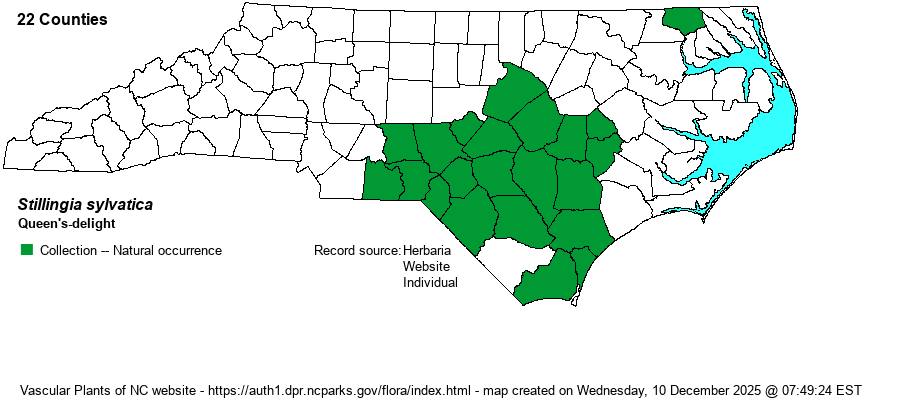| Author | Garden ex L. | |
| Distribution | Sandhills and adjacent lower Piedmont, and southwestern Coastal Plain, east only to Greene, Lenoir, and Pender counties -- not ranging eastward to the Longleaf Pine (Pinus palustris) forests in Craven, Carteret, and Onslow counties. Two disjunct occurrences in Gates County.
Southeastern VA to southern FL, southern TX, NM, and northern Mex. | |
| Abundance | Fairly common to frequent in the Sandhills, but less numerous (infrequent) to the southeast toward the coast. Very rare in the edge of the Piedmont and in the northern Coastal Plain. Populations are well spaced out on the landscape; it does not occur in colonies. | |
| Habitat | Dry to mesic Longleaf Pine-Wiregrass uplands, sandhills, dry savannas, open pine-oak-hickory woodlands. |
| Phenology | Flowering and fruiting May-July. | |
| Identification | Queen's-delight is unique in several ways and easy to identify. Plants typically are glabrous and multi-stemmed from a central point, 1-2.5 feet long and leaning to somewhat prostrate, and leafy (often whorled around the stem) with bright green elliptical leaves. Inflorescences are terminal on short branches, composed of densely yellow-flowered spikes 2-4.5 inches long. Fruits are 3-angled capsules that turn gray and last into midwinter. This is a frequently encountered species in the Sandhills, never truly common, but readily noticed owing to its multiple stems spreading outward from a common base, the whorled elliptical leaves, and (if present) the long yellow spikes. | |
| Taxonomic Comments | None
| |
| Other Common Name(s) | Queen's-root, Yawroot | |
| State Rank | S4 | |
| Global Rank | G5 | |
| State Status | | |
| US Status | | |
| USACE-agcp | | |
| USACE-emp | | |

